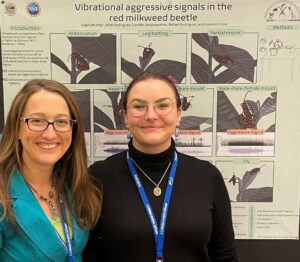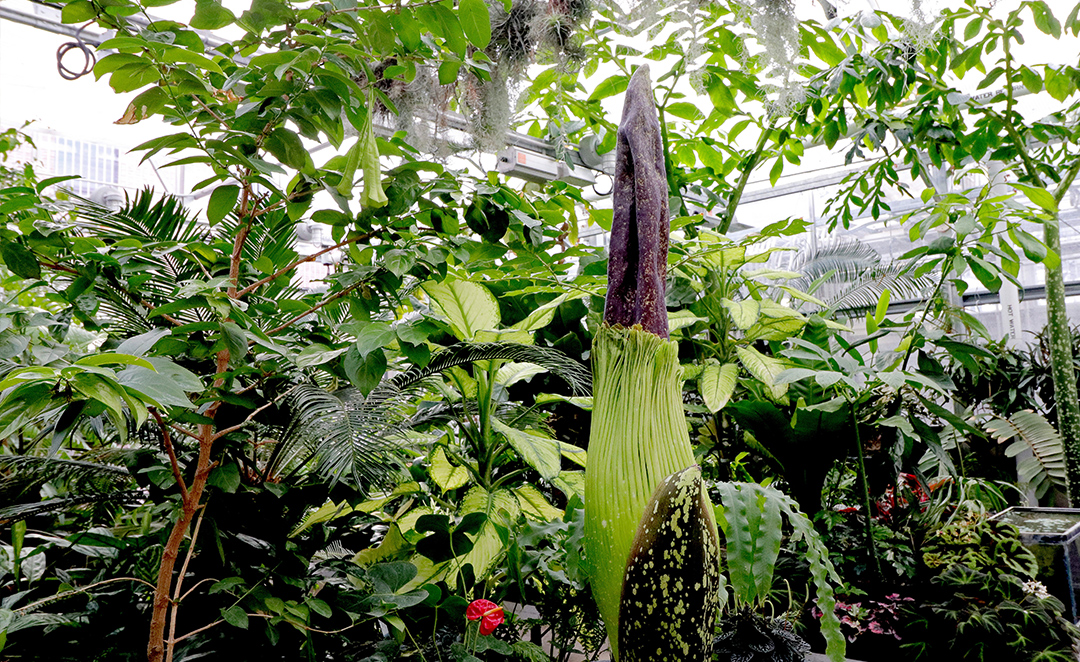The greenhouse is a 9,625 square foot hidden gem located on the roof of the NWQ Building Complex. The state-of-the-art facility maximizes research capability and provides an open, flexible environment for botanical instruction, supporting both undergraduate and graduate education and cutting-edge NSF funded research.
The facility is divided into 3 wings, with 18 separate rooms and includes an expanded head house utilized as both a potting area and a classroom, modern wet lab space, a vibration lab, 4 instructional houses, 1 propagation house, 6 research houses, a cold room, an office and student lounge, and greenhouse support spaces, with an additional 1,200 square feet of outdoor planting beds available for research and instruction.

The diverse instructional plant collection comprises approximately 672 species representing over 100 plant families, showcasing a range of plant biodiversity, evolution and adaptation, with specimens representing lower vascular plant lineages, to cycads, to a strong representation of flowering plants. The greenhouse maintains a collection of native plants which is supplemented by 270 tree and shrub species planted throughout the campus. An 11-acre conservancy area on campus is also available for study. Lapham Hall houses 17 plant growth, insect, environmental or cold chambers for research and instructional use.

For questions or to visit, please contact Greenhouse Manager Paul Engevold at 414-229-4248, or via email (preferred) at engevold@uwm.edu.
Greenhouse Policy & Procedures
Greenhouse Chemical Hygiene Plan
The Biological Sciences Greenhouse facility houses both long-term research, supporting the work of faculty members, and short-term projects for undergraduate and graduate student research.
Recent research publications include:

Shelton, WR, Mitchell, R, Christopher, D, Jack, L & Karron, JD. 2024. Among‐individual variation in flowering phenology affects flowering synchrony and mating opportunity. American Journal of Botany 111(1): e16269. https://doi.org/10.1002/ajb2.16269
Cirino L, Gallagher I, Desjonquères C & Rodríguez RL. 2023. Robust mate preferences despite means and opportunity for mate choice copying in an insect. Animal Behaviour. (in press).
Desjonquères C & Rodríguez RL. 2023. The direction and strength of social plasticity in mating signals and mate preferences vary with the life stage of induction. Animal Behaviour. (in press).
Desjonquères C, Speck B, Seidita S, Cirino L, Escalante I, Sergi C, Maliszewski J, Wiese C, Hoebel G, Bailey NW & Rodríguez RL. 2023. Social plasticity enhances signal-preference co-divergence. American Naturalist. (in press).
Rodríguez RL. 2023. Rafael Lucas Rodríguez Caballero: humanist, botanist and conservationist. Tropical Journal of Environmental Sciences (Revista de Ciencias Ambientales) 57, 1-11. (article in Spanish).
Huang, J., Zhao, L., Malik, S. et al. 2022. Specification of female germline by microRNA orchestrated auxin signaling in Arabidopsis. Nat Commun 13, 6960. https://doi.org/10.1038/s41467-022-34723-6
Grothjan, J.J. & Young, E.B. 2022. Bacterial Recruitment to Carnivorous Pitcher Plant Communities: Identifying Sources Influencing Plant Microbiome Composition and Function. Front. Microbiol. 13:791079. doi: 10.3389/fmicb.2022.791079
Grothjan, J. Microbial communities hosted by carnivorous pitcher plants: diversity, recruitment, functions and succerssion in Sarracenia purpurea microbiomes. PhD Dissertation, University of Wisconsin – Milwaukee, Milwaukee, WI., 2021.
Bittleston, L.S., Freedman, Z.B., Bernardin, J.R., Grothjan, J.J., Young, E.B., Record, S., Baiser, B., Gray, S.M. 2021. Exploring microbiome functional dynamics through space and time with trait-based theory. mSystems 6:e00530-21. https://doi.org/10.1128/mSystems.00530-21
Christopher, D.A., Karron, J.D., Semski, W.R., Smallwood, P.A., Trapnell, D.W., & Mitchell, R.J. 2021. Selfing Rates Vary with Floral Display, Pollinator Visitation, and Plant Density in Natural Populations of Mimulus ringens. Journal of Evolutionary Biology. https://doi.org/10.1111/jeb.13781
Welmillage, S.U., Zhang, Q., Sreevidya, V.S., Sadowsky, M.J. & Prasad, G. 2021. Inoculation of Mimosa pudicawith Paraburkholderia phymatum Results in Changes to the Rhizoplane Microbial Community Structure 36(1): https://doi.org/10.1264/jsme2.ME20153
Desjonquères, C., Maliszewski, J. & Rodríguez, R.L. 2021. Juvenile social experience and practice have a switch-like influence on adult mate preferences in an insect. Evolution. https://doi.org/10.1111/evo.14180
Christopher, D. A., Mitchell, R. J., Trapnell, D. W., Smallwood, P. A., Semski, W. R. and J. D. Karron. 2020. Edge effects and mating patterns in a bumblebee-pollinated plant. AoB Plants 12(4): 1-7.
Byers, H. L., McHenry, L. J., & Grundl, T. J. 2020. Increased risk for lead exposure in children through consumption of produce grown in urban soils. Science of The Total Environment 743: 1-12.
Yuan, X., Zeng, Q., Xu, J., Severin, G.B., Zhou, X., Waters, C.M., Sundin, G.W., Ibekwe, A.M., Liu, F., & Yang, C.H.. 2020. Tricarboxylic Acid (TCA) Cycle Enzymes and Intermediates Modulate Intracellular Cyclic di-GMP Levels and the Production of Plant Cell Wall-Degrading Enzymes in Soft Rot Pathogen Dickeya dadantii. Mol Plant Microbe Interact 33:296-307.
Speck, B., Seidita, S., Belo, S., Johnson, S., Conley, C., Desjonquères, C., and Rodríguez, R.L. 2020. Combinatorial signal processing in an insect. The American Naturalist 196(4): 406-413.
Desjonquères, C., Holt, R. R., Speck, B., and Rodríguez, R.L. 2020. The Relationship between a combinatorial processing rule and a continuous mate preference function in an insect. Proceedings of the Royal Society B 287(1935): 1-10.
Grothjan, J.J. & Young, E.B. 2019. Diverse microbial communities hosted by the model carnivorous pitcher plant Sarracenia purpurea: analysis of both bacterial and eukaryotic composition across distinct host plant populations. PeerJ7:e6392. http://doi.org/10.7717/peerj.6392
Christopher, D. A., Mitchell, R. J., Trapnell, D. W., Smallwood, P. A., Semski, W. R. and J. D. Karron. 2019. Hermaphroditism promotes mate diversity in flowering plants. American Journal of Botany 106(8): 1131–1136.
Yuan. X., Zeng, Q., Khokhani, D., Tian, F., Severin, G.B., Waters, C.M., Xu, J., Zhou, X., Sundin, G.W., Ibekwe, A.M., Liu, F., & Yang, C.H. 2019. A feed-forward signaling circuit controls bacterial virulence through linking cyclic di-GMP and two mechanistically distinct sRNAs, ArcZ and RsmB. Environ Microbiol 21:2755-2771.
Byers, H. L., McHenry, L. J., & Grundl, T. J. 2019. XRF techniques to quantify heavy metals in vegetables at low detection limits. Food Chemistry: X, 1, 100001.
Gao, T., Ding, M., Yang, C.H., Fan, H., Chai, Y., & Li, Y. 2019. The phosphotransferase system gene ptsH plays an important role in MnSOD production, biofilm formation, swarming motility, and root colonization in Bacillus cereus 905. Res Microbiol 170:86-96.
Cui, Z., Yang, C.H., Kharadi, R.R., Yuan, X., Sundin, G.W., Triplett, L.R., Wang, J., & Zeng, Q. 2019. Cell-length heterogeneity: a population-level solution to growth/virulence trade-offs in the plant pathogen Dickeya dadantii.PLoS Pathog 15:e1007703.
Desjonqueres, C., Maliszewski, J., Lewandowski, E. N., Speck, B., & Rodriguez, R. L. 2019. Social ontogeny in the communication system of an insect. Animal Behaviour 148: 93-103.
Smith, A. R. Dissection of floral organ development and sterility in Sorghum bicolor. PhD Dissertation, University of Wisconsin – Milwaukee, Milwaukee, WI., 2019.
Rodriguez, R. L., Wojcinski, J. E., & Maliszewski, J. 2018. Between-group variation in Echenopa treehopper juvenile signaling (Hemiptera Membracidae). Ethology Ecology & Evolution 30(3): 245-255.
Wefferling, K. W. Disentangling the subalpine marshmarigold species complex: the cytogeography, phylogeography, and the systematics of Caltha biflora DC., C. chionophila Greene, and C. leptosepala DC. (Ranunculaceae). PhD Dissertation, University of Wisconsin – Milwaukee, Milwaukee, WI., 2018.
Young, E. B., Sielicki, J., & Grothjan, J. J. 2018. Regulation of hydrolytic enzyme activity in aquatic microbial communities hosted by carnivorous pitcher plants. Microbial Ecology (76)4: 885-898.
Zeng, Q., Cui, Z., Wang. J., Childs, K.L., Sundin, G.W., Cooley, D.R., Yang, C.H., Garofalo, E., Eaton, A., Huntley, R.B., Yuan, X., & Schultes, N.P. 2018. Comparative genomics of Spiraeoideae-infecting Erwinia amylovora strains provides novel insight to genetic diversity and identifies the genetic basis of a low-virulence strain. Mol Plant Pathol 19:1652-1666.
Zhao, C. Z., Huang, J., Gyaneshwar, P., & Zhao, D. 2018. Rhizobium sp. IRBG74 alters Arabidopsis root development by affecting auxin signaling. Frontiers in Microbiology 8: 2556.
Fowler-Finn, K. D., Cruz DC & Rodríguez RL. 2017. Local population density and group composition influence signal-preference relationships in Enchenopa treehoppers (Hemiptera: Membracidae). Journal of Evolutionary Biology 30, 13-25.
Fowler-Finn, K. D., Kilmer, J. T., Cruz, D. C., & Rodriguez, R. L. 2017. Female mate choice of male signals is unlikely to promote ecological adaptation in Echenopa treehoppers (Hemiptera Membracidae). Ecology and Evolution 8: 2146-2159.
Hallett, A. C., Mitchell, R. J., Chamberlain, E. R., & Karron, J. D. 2017. Pollination success following loss of a frequent pollinator: the role of compensatory visitation by other effective pollinators. AoB Plants 9(3): plx020.
Wefferling, K. W., Castro, S., Loureiro, J., Castro, M., Tavares, D., & Hoot, S. B. 2017. Cytogeography of the subalpine marsh marigold polyploid complex (Caltha leptosepala s.l., Ranunculaceae). American Journal of Botany 104(2): 271-285.
Xin, Z., Huang, J., Smith, A. R., Chen, J., Burke, J., Sattler, S. E., & Zhao, D 2017. Morphological characterization of a new and easily recognizable nuclear male sterile mutant of sorghum (Sorghum bicolor). PLoS ONE 12(1): e0165195.
